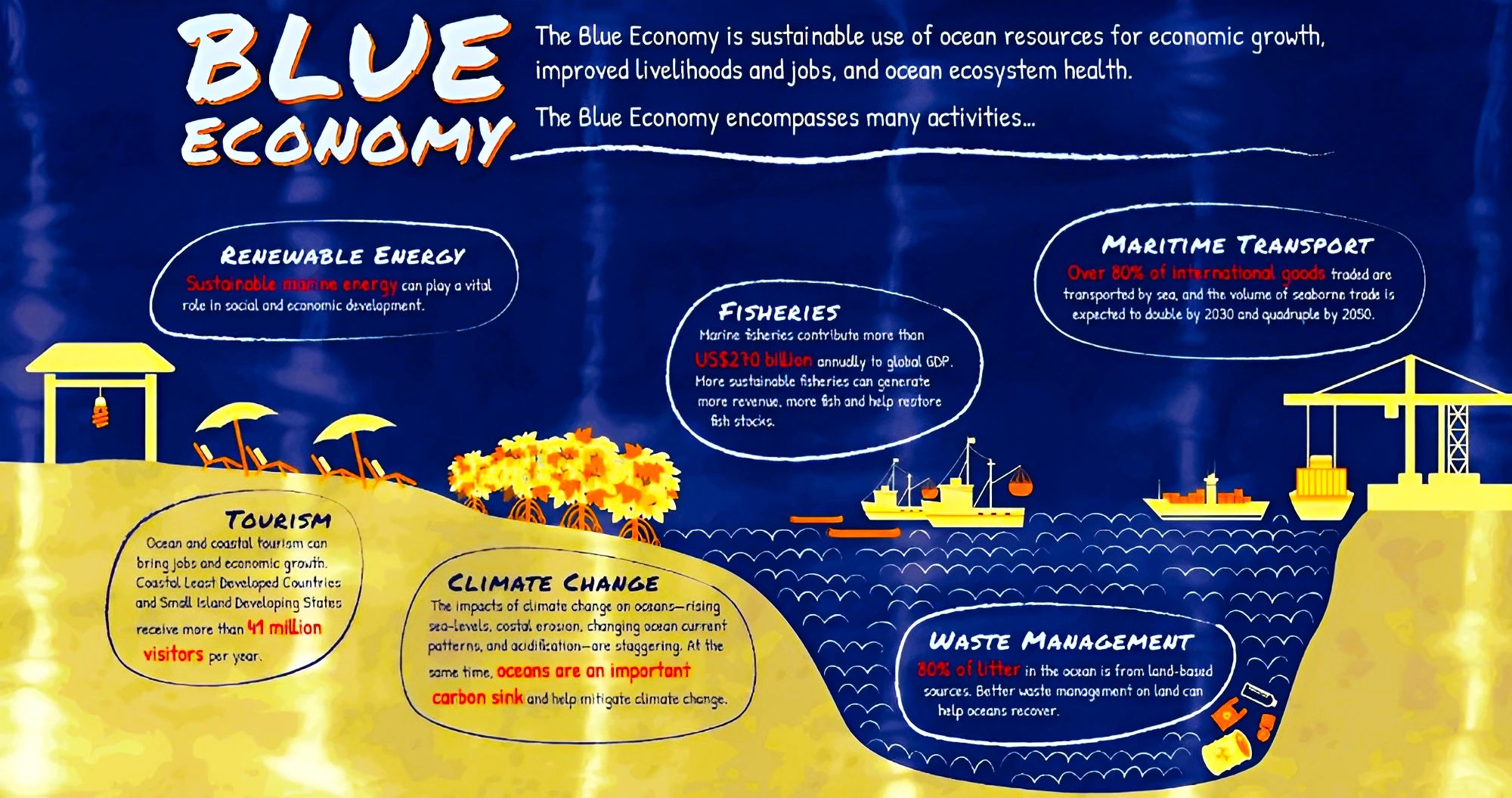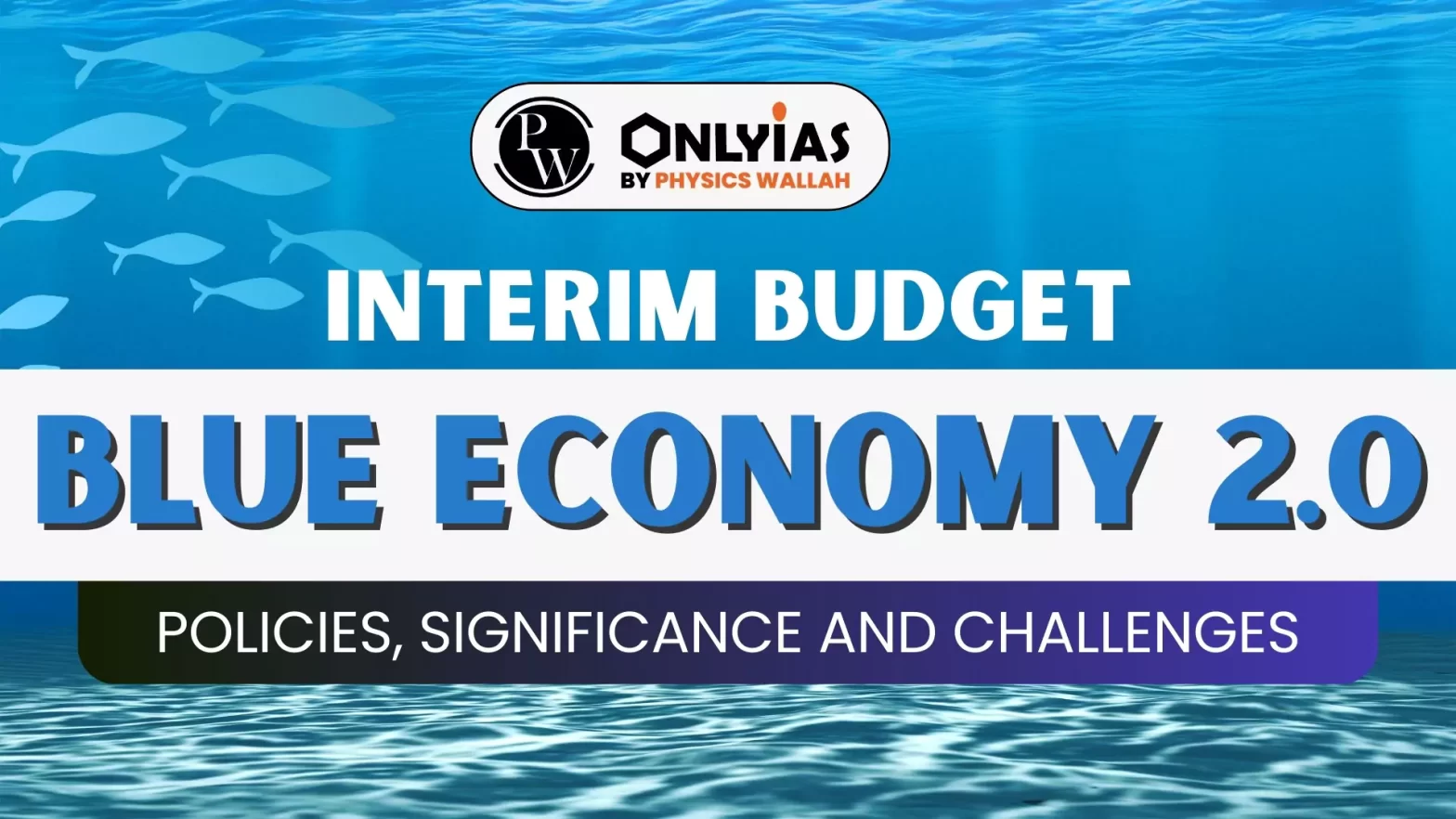Context:
This article is based on the news “Interim budget mentions blue economy 2.0: What this means” which was published in the Indian Express. Recently, the Interim Budget 2024-25 presented by the Union Finance Minister stressed on environment-friendly development through the promotion of “blue economy 2.0”.
Blue Economy & Responsible AI in Focus at G20
- India, as the host of the G20 summit, prioritised blue economy discussions.
- The Comptroller & Auditor General of India chaired the Engagement Group for Supreme Audit Institutions (SAls) of the member countries in June 2023, wherein two priorities were blue economy and responsible Artificial Intelligence.

What is Blue Economy?
- The Concept of Blue Economy was introduced by Gunter Pauli in his 2010 book- “The Blue Economy: 10 years, 100 innovations, 100 million jobs”.
- Blue Economy Meaning: As per the World Bank, the blue economy is the “sustainable use of ocean resources for economic growth, improved livelihoods, and jobs while preserving the health of the ocean ecosystem”.
Interim Budget on Blue Economy 2.0
- Restoration and Adaptation: A scheme for restoration and adaptation measures, and coastal aquaculture and mariculture with integrated and multi-sectoral approach will be launched.
- Integrated Aqua Parks: The setting up of five integrated aqua parks is also announced.
- Pradhan Mantri Matsya Sampada Yojana (PMMSY): PMMSY would be enhanced to double the exports to Rs 1 lakh crore and generate 55 lakh employment opportunities.
- Aquaculture: A broad term that refers to the farming of aquatic plants and animals.
- Mariculture: It refers to rearing and harvesting marine creatures in saltwater.
|
India’s Blue Economy Policy
- A draft blue economy policy India on India’s Blue Economy was first released in July 2022.
- Focus Areas: Manufacturing, Emerging Industries, Trade, Technology, Services and Skill Development, Logistics, Infrastructure and Shipping, Coastal and Deep-Sea Mining and Offshore Energy and Security, Strategic Dimensions and International Engagement.
- Recommendations: It contained key recommendations on National Accounting Framework for Blue Economy and Ocean Governance, Coastal Marine Spatial Planning and Tourism Priority, Marine Fisheries, Aquaculture and Fish Processing.
Steps Taken By India for Blue Economy
- Deep Ocean Mission: It was launched by the Ministry of Earth Sciences to boost India’s maritime infrastructure and harness the living and non-living resources from the deep-oceans.
- Blue Economy Vision 2025: Harnessing Business Potential for India Inc and International Partners is a pioneering effort by FICCI to sensitise about the growing global and regional emphasis on sustainability of harnessing the ocean resources.
- National Fisheries Policy of India: It focuses on sustainable utilisation of fisheries wealth from marine and other aquatic resources.
- Sagarmala Project: It is the strategic initiative for port-led development through the extensive use of IT enabled services for modernization of ports.
- O-SMART: It aims at regulated use of oceans, marine resources for sustainable development.
- Integrated Coastal Zone Management: It focuses on conservation of coastal and marine resources, and improving livelihood opportunities for coastal communities etc.
- India-Norway Task Force on Blue Economy for Sustainable Development: In 2020, both countries inaugurated it to develop and follow up joint initiatives.
Significance of India’s Blue Economy
- Highly Profitable: According to research commissioned by the high-level panel for a sustainable ocean economy, USD1 invested in key ocean activities yields five times return, often more.
- India’s blue economy supports 95% of the country’s business through transportation and contributes an estimated 4% to its Gross Domestic Product.
- Achievement to SDG: It supports all of the United Nations’ Sustainable Development Goals (SDGs), especially SDG14 ‘life below water’.
- Sustainable Energy: Supporting the increasing demand for renewable energy, offshore regions have tremendous potential in the form of offshore wind, waves and ocean currents.
Challenges for India’s Blue Economy
- Fragmented Fishing Industry with lack of access to credit and modern technology hinders blue economy growth.
- Climate Change and Natural Disasters pose significant threats such as sea-level rise, increased ocean acidity, etc.
- Waste and Pollution such as marine litter, chemical pollutants, and untreated sewage.
- Invasive species through oil spills can disrupt marine ecosystems and negatively impact indigenous species and industries.
- Congestion in Ports due to inadequate maintenance infrastructure, inefficient operations, and high cargo volumes, leading to delays and increased costs.
Conclusion
With India’s vast maritime interests, the blue economy holds a significant position in India’s economic growth, employment generation, equity and protection of environment. It is the right time to achieve the best of its potential while maintaining the sustainability of the marine environment.
Also Read: Harnessing The Potential Of Fisheries Sector
![]() 3 Feb 2024
3 Feb 2024



